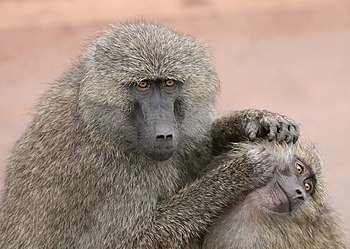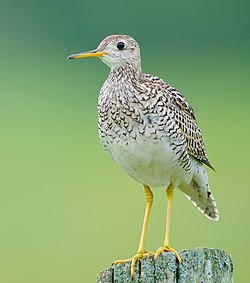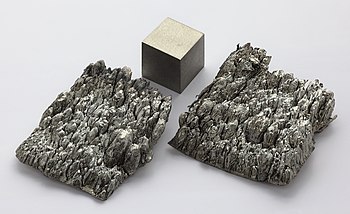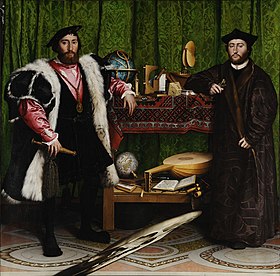Wikipedia:Picture of the day/April 2012
|
Featured picture tools: |
These featured pictures, as scheduled below, appeared as the picture of the day (POTD) on the English Wikipedia's Main Page in April 2012. Individual sections for each day on this page can be linked to with the day number as the anchor name (e.g. [[Wikipedia:Picture of the day/April 2012#1]] for April 1).
You can add an automatically updating POTD template to your user page using {{Pic of the day}} (version with blurb) or {{POTD}} (version without blurb). For instructions on how to make custom POTD layouts, see Wikipedia:Picture of the day.
April 1

|
A drawing of the Vegetable Lamb of Tartary (Agnus scythicus), a zoophyte of Central Asia. Botanist Henry Lee described it as both a true animal and a living plant, although he did allow for the possibility that the lamb was the fruit of the plant. The lamb was believed to have blood, bones, and flesh like that of a normal lamb. It was connected to the earth by a stem similar to an umbilical cord that propped the lamb up above ground. The cord could flex downward allowing the lamb to feed on the grass and plants surrounding it. Once the plants within reach were eaten, the lamb died, at which point its cotton-like wool would be harvested and used to make textiles. Artist: Unknown, after Johann Zahn
Recently featured: |
April 2

|
Poli's stellate barnacle (Chthamalus stellatus) is a species of acorn barnacle common on rocky shores in South West England, Ireland, and Southern Europe. It is named after Italian scientist Giuseppe Saverio Poli. Depending upon environmental conditions and the amount of food available, it can reach up to 14 mm (0.55 in) in diameter. Photo: Michael Maggs
Recently featured: |
April 3

|
The Tasmanian Darner (Austroaeschna tasmanica) is an Australian species of dragonfly in the Aeshnidae family, which includes some of the largest of the dragonflies on the planet. Also referred to as "hawkers", the name "darner" derives from the fact that the female abdomens look like a sewing needle, as they cut into plant stem when they lay their eggs through the ovipositor. Photo: JJ Harrison
Recently featured: |
April 4

|
Two olive baboons (Papio anubis) engaged in social grooming, an activity that social animals (including humans) engage in to clean or maintain one another's body or appearance. Grooming also reinforces social structures, family links, and builds relationships. It has been best studied among primates, but insects, birds, fish, and other mammals are known to engage in it as well. Photo: Muhammad Mahdi Karim
Recently featured: |
April 5

|
The Battenberg Mausoleum is the memorial tomb of Prince Alexander of Battenberg, the first ruler of modern Bulgaria. Located in the Sofia city centre, the structure opened in 1897, four years after Alexander's death on April 5, 1893, in Graz, Austria, where he was initially buried. However, in accordance with his wish, his remains were transferred to Sofia where he was given a state funeral. Photo: Plamen Agov
Recently featured: |
April 6

|
The elegant sunburst lichen (Xanthoria elegans) is a lichen recognizable by its bright orange or red pigmentation. This species grows on rocks, often near bird or rodent perches. It has a circumpolar and alpine distribution. It was one of the first lichens to be used for the rock-face dating method known as lichenometry. Photo: Jason Hollinger
Recently featured: |
April 7

|
The Upland Sandpiper (Bartramia longicauda) is a large sandpiper species, closely related to the curlews, found across central North America and Alaska. Unlike other members of its family, it is not associated with water, but instead lives in fields and open grassland. It is a long-distance migrant and winters in South America. Photo: Johnathan Nightingale
Recently featured: |
April 8

|
An 1880 Baxter process colour plate illustrating Revelation 22:17 from the Bible, in which the Holy Spirit and the Bride of Christ give access to the Water of Life to those who have survived the cataclysmic events described in the book. The text reads, "And the Spirit and the bride say, Come. And let him that heareth say, Come. And let him that is athirst come. And whosoever will, let him take the water of life freely." The Bride is usually taken to mean the Christian Church, but other interpretations exist. Image: Joseph Martin Kronheim; Restoration: Adam Cuerden
Recently featured: |
April 9

|
A plate with fossils of Pseudostacus sp. (lobster, left) and Diplomystus birdii (fish, right), from the Hakel paleontological formation in Lebanon. The paleontological sites of Lebanon contain deposits of some of the best-preserved fossils in the world, and include some species found nowhere else. The most famous of these is the Lebanese lagerstätten of the Late Cretaceous age. Photo: Mbz1
Recently featured: |
April 10

|
The Australian blenny (Ecsenius australianus) is a small marine blennioid fish native to the shallow waters of the Great Barrier Reef and Coral Sea. It grows up to 6 cm (2.4 in) in length. Photo: Nick Hobgood
Recently featured: |
April 11

|
|
A 1773 engraving showing the Greek legend of the Calydonian Boar, which was sent by Artemis to ravage the region of Calydon in Aetolia because its king failed to honor her in his rites to the gods. Many Olympian heroes took part in hunting the boar, and it was eventually killed by Meleager and Atalanta, as depicted here. Engraving: François Louis Lonsing, after Giulio Romano; Restoration: Adam Cuerden
Recently featured: |
April 12

|
Two samples of sublimed-dendritic scandium and an argon arc remelted 1 cm3 cube sample for comparison. Scandium is a silvery-white transition metal that is used to make aluminium alloys. Although it is common in the Earth's crust, it is distributed sparsely and occurs only in trace amounts in many minerals. Photo: Alchemist-hp |
April 13

|
|
A photomontage showing an MH-60S Knighthawk helicopter assigned to the "Dragon Whales" of Helicopter Combat Support Squadron Eight engaged in vertical replenishment, a method of supply of seaborne vessels. Here, it can be seen flying between USS Harry S. Truman and the Military Sealift Command ammunition ship USNS Mount Baker carrying a payload of bombs. Photo: John L. Beeman, United States Navy
Recently featured: |
April 14

|
The Metallic Ringtail (Austrolestes cingulatus) is an Australian species of damselfly, so named because of its glossy metallic colouration and the "rings" on each abdominal segment. It is widely distributed in Tasmania, Victoria, eastern New South Wales and south eastern Queensland. Photo: JJ Harrison
Recently featured: |
April 15

|
A level junction interlaced turnout at Chicago Transit Authority signal tower 18 on the elevated Chicago 'L'. Known as a "flat crossing" in the United Kingdom, this type of railway junction allows trains to cross over in front of opposing traffic at grade (i.e., on the level). The opposite of a level junction is a flying junction, where individual tracks rise or fall to pass over or under other tracks. Photo: Daniel Schwen
Recently featured: |
April 16

|
Sir Peter Ustinov (1921–2004) was an English actor, writer and dramatist. A noted wit and raconteur, he was a fixture on television talk shows and lecture circuits for much of his career. He was also a respected intellectual and diplomat who, in addition to his various academic posts, served as a Goodwill Ambassador for UNICEF and President of the World Federalist Movement. Ustinov was the winner of numerous awards over his life, including Academy Awards, Emmy Awards, BAFTA Awards, Golden Globes, and a Grammy Award. Photo: Allan Warren
Recently featured: |
April 17

|
The Eastern Spinebill (Acanthorhynchus tenuirostris, female shown here) is a species of honeyeater found in south-eastern Australia. It feeds on nectar from many plants, as well as small insects and other invertebrates. It is around 15 cm (5.9 in) long, and has a distinctive black, white and chestnut plumage, a red eye, and a long downcurved bill. Photo: JJ Harrison
Recently featured: |
April 18

|
Meteor Crater is a meteorite impact crater approximately 43 miles (69 km) east of Flagstaff, Arizona, US. It was created about 50,000 years ago during the Pleistocene epoch. The object that excavated the crater was a nickel-iron meteorite about 50 m (160 ft) across, which impacted the plain at a speed of several km per second. Photo: National Map Seamless Server, USGS
Recently featured: |
April 19

|
A view of Black Tusk in Garibaldi Provincial Park, British Columbia, Canada. It is the core of an extinct stratovolcano, formed about 1.2 million years ago when the loose cinder around it eroded, leaving only the hard lava core. At 2,319 m (7,608 ft) above sea level, it is particularly noticeable from the Sea-to-Sky Highway just south of Whistler, B.C. Photo: Andysonic777
Recently featured: |
April 20

|
On April 20, 2010, an explosion aboard the semi-submersible oil platform Deepwater Horizon started a massive oil spill caused by a sea-floor gusher that released an estimated 53,000 barrels per day (8,400 m3/d) of crude oil before it was capped. This picture from the Terra satellite shows sunlight reflecting off the oil (center) a little over one month after the explosion. Photo: NASA/GSFC, MODIS Rapid Response Team
Recently featured: |
April 21

|
A nudibranch (Nembrotha lineolata, right) lays eggs in a spiral pattern on a sea squirt (Polycarpa aurata). Sea squirts are sessile filter feeding marine animals found in shallow waters throughout the world's oceans. They are the natural prey of many animals and are consumed by humans as well. Photo: Nick Hobgood
Recently featured: |
April 22

|
|
Focus stacking is a digital image processing technique which combines multiple images taken at different focus distances to give a resulting image with a greater depth of field (DOF) than any of the individual source images. Getting sufficient DOF can be particularly challenging in macro photography, because it is smaller (shallower) for objects nearer the camera, so if a small object fills the frame, it is often so close that its entire depth cannot be in focus at once. By taking several images, each with a different portion of the subject in focus, and combining them digitally, blurry sections can be eliminated. Photo: Muhammad Mahdi Karim
Recently featured: |
April 23

|
The pear-shaped puffball (Lycoperdon pyriforme) is a saprobic fungus present throughout much of the world. Emerging in autumn, this puffball is common and abundant on decaying logs of both deciduous and coniferous wood. It is considered a choice edible when still immature and the inner flesh is white. Photo: Sasata
Recently featured: |
April 24

|
An 1898 photochrom print of a cattle roundup in Cimarron, Colorado, US. Known as a muster in Australia and New Zealand, the North American roundup was an iconic image of the American Old West: the gathering of cattle in the open range, followed by them being driven vast distances from ranches to distant railheads over a period of several weeks. Photographer: William Henry Jackson;
Recently featured: |
April 25
|
A view of animals and tourists inside Ngorongoro Crater in Tanzania's Ngorongoro Conservation Area, a UNESCO World Heritage Site. The crater is a large volcanic caldera, which formed when a giant volcano exploded and collapsed on itself some two to three million years ago. It is 610 m (2,000 ft) deep and its floor covers 260 km2 (100 sq mi). Photo: Muhammad Mahdi Karim
Recently featured: |
April 26

|
Husband and wife Steven Archer and Donna Lynch of the American darkwave/industrial rock band Ego Likeness. Taking their name from Frank Herbert’s science fiction novel Dune, the band formed in 1999 and has been touring and recording albums since. Photo: Kyle Cassidy
Recently featured: |
April 27

|
United States Navy personnel engage in Special Patrol Insertion/Extraction (SPIE) training between a Sikorsky SH-60 Seahawk helicopter and the USS Dwight D. Eisenhower (CVN-69). SPIE involves either a person or goods being lowered from or raised to a helicopter via a cable above terrain on which landing would be difficult. Photo: Miguel Angel Contreras, U.S. Navy
Recently featured: |
April 28

|
The Ambassadors (1533) is a painting by Hans Holbein the Younger in the National Gallery, London. As well as being a double portrait, the painting contains a still life of several meticulously rendered objects, the meaning of which is the cause of much debate. The most notable and famous of Holbein's symbols in the work is the skewed skull, rendered in anamorphic perspective, which is placed in the painting's bottom centre. It is meant to be a visual puzzle as the viewer must approach the painting nearly from the side to see the form morph into an accurate rendering of a human skull. Image: Google Art Project
Recently featured: |
April 29

|
The warthog (Phacochoerus africanus) is a wild member of the pig family that lives in grassland, savanna, and woodland in Sub-Saharan Africa. The common name comes from the four large wart-like protrusions found on the head of the warthog, which serve as a fat reserve and are used for defence when males fight. Photo: Ikiwaner |
April 30

|
Lee Bollinger (b. 1946) is an American lawyer and educator who is currently serving as the 19th president of Columbia University as well as the chairman of the Federal Reserve Bank of New York board of directors. Formerly the president of the University of Michigan, he is a noted legal scholar of the First Amendment and freedom of speech. Photo: Daniella Zalcman/PLW |
Picture of the day archives and future dates

